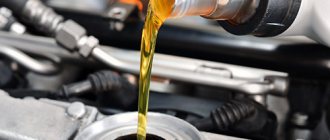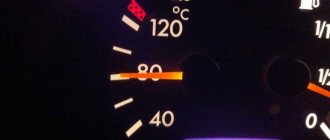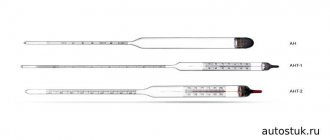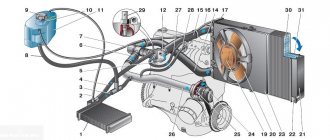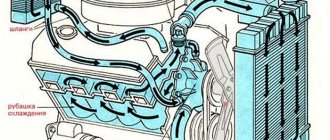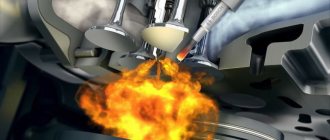Gasoline and its characteristics. A mixture, flammable, of light hydrocarbons with a boiling point from 33 to 205 °C. Density about 0.71 g/cm³. Calorific value approximately 10,200 kcal/kg (46 MJ/kg, 32.7 MJ/liter). Freezing point −72 °C when using special additives. Gasoline is a product of oil refining. It is a fuel with low detonation characteristics. There are: natural gasoline, cracked gasoline, polymerization products. Also liquefied petroleum gases and all products used as industrial motor fuels. Gasoline is the most common fuel for most types of transport.
Piston internal combustion engines
Gasolines are intended for use in piston internal combustion engines with forced ignition (spark). Depending on their purpose, they are divided into automobile and aviation. Despite the differences in application conditions, automobile and aviation gasolines are characterized mainly by general quality indicators. Their physicochemical and operational properties are different. Modern automobile and aviation gasolines must satisfy a number of requirements.
They must ensure economical and reliable operation of the engine (Gasoline and its characteristics). Operating requirements: have good volatility, allowing you to obtain a homogeneous air-fuel mixture of optimal composition. At any temperature; have a group hydrocarbon composition that ensures a stable, detonation-free combustion process. Do not change its composition and properties in all engine operating modes. During long-term storage, do not have a harmful effect on parts of the fuel system, tanks, rubber products, etc. In recent years, the environmental properties of fuel have come to the fore.
Composition of gasolines
Gasoline is a mixture of hydrocarbons consisting mainly of saturated 25-61%, unsaturated 13-45%, naphthenic 9-71%, aromatic 4-16% hydrocarbons with a hydrocarbon molecule length from C 5 to C 10 and a number of carbon atoms from 4 -5 to 9-10 with an average molecular weight of about 100D. Gasoline may also contain impurities - sulfur-, nitrogen- and oxygen-containing compounds. Gasoline is the lightest fraction of the liquid fractions of oil (Gasoline and its characteristics). This fraction is obtained through various oil sublimation processes. Therefore, the ease and reliability of engine starting, completeness of combustion, warm-up duration, vehicle response and wear rate of engine parts depend on the fractional composition of gasoline. The fractional composition of gasoline is determined according to GOST 2177-99.
Light fractions of gasoline characterize the starting properties of the fuel - the lower the boiling point of the fuel, the better the starting properties. To start a cold engine, it is necessary that 10% of gasoline boils away at a temperature not exceeding 55 degrees (winter grade) and 70 degrees (summer grade) Celsius. Winter grades of gasoline have a lighter (than summer) fractional composition. Light fractions are needed only for the period of starting and warming up the engine. The main part of the fuel is called the working fraction. Its volatility determines: the formation of a combustible mixture under different engine operating modes, the duration of warm-up (transfer from idle to load), throttle response (the ability to quickly transfer from one mode to another). The content of the working fraction should coincide with 50% of the distillate. The minimum temperature range from 90% to the end of boiling improves the quality of the fuel and reduces its tendency to condense, which increases efficiency and reduces wear of engine parts. The 90% boiling point of a fuel is sometimes called the dew point.
Boiling point, combustion temperature of gasoline
Any person who decides to find information about the boiling, combustion or ignition temperature of fuel will find an interesting thing: even in fairly well-known sources there is a difference between the indicated indicators of the same parameter. Why does this happen and what are the real indicators?
Gasoline boiling point
The boiling point of gasoline is an interesting value. Today, few young motorists know that once upon a time, at high air temperatures, fuel boiling in the fuel line or carburetor could block the vehicle. This phenomenon contributed to the formation of failures in the system.
The light fractions were strongly heated and separated from the heavier ones in the form of bubbles of flammable gas. The car cooled down, the gases turned into liquid - and it was possible to continue moving. Today, gasoline used at gas stations boils at approximately +80 degrees.
Fuel flash point
The flash point of a fuel is the thermal threshold at which freely separating, lighter fractions of the fuel begin to burn from an open flame source when this source is located above the test sample.
In practice, it has been shown that the flash point is determined by the method of heating in an open crucible. The fuel to be tested is poured into a small open container. Then it is heated slowly without involving an open flame.
At the same time, the temperature is monitored in real time. Each time the fuel temperature increases by 1 degree, a flame source is used at a low altitude above its surface. At this moment, when fire occurs, the flash point is determined.
In other words, the flash point determines the threshold at which the concentration of easily evaporating fuel in the air reaches a level sufficient to ignite under the influence of an open fire source.
Gasoline combustion temperature
This indicator reveals the maximum temperature created by burning gasoline. And here, too, there is no unambiguous information that answers this question with one number. Surprisingly, it is for the combustion temperature that the key role is played by the conditions of the process, and not the composition of gasoline.
If you look at the calorific value of different gasolines, there are no differences between AI 92 and AI 100. In fact, the octane number only reveals the resistance of gasoline to the occurrence of combustion processes.
And the quality of the essence itself and its combustion temperature are not affected. By the way, often simple gasolines AI 76 and AI 80, which have gone out of use, are cleaner and safer for humans than AI 98, modified with a large number of additives.
In the engine, the combustion temperature of the fuel ranges from 900 to 1100 degrees. This is if the ratio of air and fuel is equal to the stoichiometric ratio. The actual combustion temperature can either decrease or increase under specific conditions.
Properties of gasolines
Gasolines are flammable, colorless or slightly yellow (in the absence of special additives) liquids with a density of 700-780 kg/m? Gasolines have high volatility, and a flash point in the range of 20-40 degrees Celsius. The boiling point of gasoline is in the range from 30 to 200 C. The pour point is below minus 60 degrees. When gasoline burns, water and carbon dioxide are formed. At vapor concentrations in the air of 70-120 g/m3, explosive mixtures are formed. Due to their physical and chemical characteristics, motor gasolines must have the following properties:
- Mixture homogeneity;
- Fuel density - at +20 °C should be 690...750 kg/m2;
- Low viscosity - as it increases, it becomes more difficult for fuel to flow through the nozzles, which leads to a lean mixture. Viscosity is highly dependent on temperature. When the temperature changes from +40 to -40 °C, gasoline consumption through the nozzle changes by 20...30%;
- Volatility is the ability to change from a liquid to a gaseous state. Motor gasoline must have such volatility that it ensures easy engine starting (especially in winter), rapid warming up, complete combustion of fuel, and also eliminates the formation of vapor locks in the fuel system;
- Saturated vapor pressure - the higher the vapor pressure during fuel evaporation in a confined space, the more intense the process of their condensation. The standard limits the upper limit of vapor pressure in summer to 670 GPa and in winter from 670 to 930 GPa. Gasolines with higher pressure are prone to the formation of vapor locks; when used, the filling of the cylinders decreases and engine power is lost, and evaporation losses increase when stored in car tanks and warehouses;
- Low temperature properties - the ability of gasoline to withstand low temperatures;
- Combustion of gasoline. “Combustion” in relation to automobile engines is understood as a rapid reaction of the interaction of fuel hydrocarbons with oxygen in the air, releasing a significant amount of heat. The temperature of the vapors during combustion reaches 1500...2400 °C.
Evaporation - gasoline
| Diagram of a simple carburetor. |
How to drain gasoline from a tank: expert advice on how to properly pump gasoline out of any tank (video + 100 photos)
Evaporation of gasoline begins from the moment it leaves the carburetor channels into the air flow in the diffuser. Under the influence of the kinetic energy of moving air, the flowing stream of gasoline is split into separate mixtures. Small drops have time to evaporate in the carburetor mixing chamber. Larger droplets are carried away by the air flow and evaporate as the mixture moves along the intake tract and in the engine cylinders. The largest drops of fuel settle on the walls of the mixing chamber and inlet pipe, forming a liquid fuel film. The steam-air flow carries the film along the walls of the intake pipe towards the combustion chambers.
| Fuel volatility and cooling of metal carburetor parts. |
The evaporation of gasoline in the engine intake system is accompanied by a decrease in the temperature of the fuel-air mixture due to the fact that the heat necessary for the evaporation of gasoline (heat of evaporation) is taken away from the air in which evaporation occurs and from the metal parts of the intake system. It was noted, for example, that at an ambient temperature of 7 5 C, the temperature of the throttle valve two minutes after starting the engine drops to - 14 C.
Evaporation of gasoline begins from the moment it leaves the atomizer and continues in an air stream moving at high speed. In this case, part of the gasoline evaporates in the intake manifold, and part - in the engine cylinder.
| Fuel volatility etc. |
The evaporation of gasoline in the engine intake system is accompanied by a decrease in the temperature of the fuel-air mixture due to the fact that the heat necessary for the evaporation of gasoline (heat of evaporation) is taken away from the air in which evaporation occurs, and. It was noted, for example, that at an ambient temperature of 7 5 C, the temperature of the throttle valve 2 minutes after starting the engine drops to - 14 C.
Evaporation of gasoline occurs during all operations (filling, storage, refueling), the amount of losses depends on the organization of work, technical equipment and condition of the equipment.
Gasoline evaporation is closely related to vapor pressure. The lower the vapor pressure, the slower the gasoline evaporates, and vice versa. At the same time, the gasoline standard limits the most permissible vapor pressure, which should not exceed 500 mm Hg.
| Typical characteristics of gasoline evaporation from oil during continuous engine operation for 1 hour on a stand. |
The evaporation of gasoline from the oil system of an aircraft in flight with oil tanks having circulation wells occurs even faster.
Gasoline evaporation is a factor that must be taken into account when organizing the transportation process. In addition to the fact that saturation of the tank or reservoir space with gasoline vapors is dangerous in terms of fire and explosions, the evaporation of gasoline changes its qualitative composition. In addition, the evaporation of gasoline causes losses during transportation.
The higher the ambient temperature, the more intense the evaporation of gasoline occurs. Therefore, when storing and transporting gasoline, they resort to a number of measures that reduce the degree of evaporation when the ambient temperature rises. To reduce evaporation, gasoline tanks and gasoline storage tanks are painted a light color.
The evaporation of gasoline in the intake pipe is accompanied by the division of gasoline into fractions. During the intake process, mainly low-boiling fractions evaporate. They, forming a steam-air mixture, enter the cylinder. High-boiling fractions settle on the wall of the intake pipe in the form of a liquid film, which, gradually evaporating, moves along the intake tract. When using high-octane gasoline, as a result of this mixture formation process during intake (especially in unsteady conditions), low-boiling fractions with a relatively lower octane number first enter the cylinder. This may lead to detonation. The greatest influence on the distribution of gasoline, which has different detonation resistance, among the cylinders is caused by the ethylation of gasoline, which is associated with the uneven distribution of tetraethylene when individual fractions boil off.
The evaporation of gasoline in the engine intake system is accompanied by a decrease in the temperature of the fuel-air mixture due to the fact that the heat necessary for the evaporation of gasoline (heat of evaporation) is taken away from the air in which evaporation occurs and from the metal parts of the intake system. It was noted, for example, that at an ambient temperature of 7 5 C, the temperature of the throttle valve 2 minutes after starting the engine drops to -14 C.
Automobile gasolines
In Russia, motor gasolines are produced in accordance with GOST 2084-77, GOST R 51105-97 and GOST R 51866-2002, as well as in accordance with TU 0251-001-12150839-2015 Gasoline AI 92.95 (Alternative). Motor gasolines are divided into summer and winter (winter gasoline contains more low-boiling hydrocarbons). The main brands of motor gasoline GOST R 51105-97: Normal-80 - with a research octane number of at least 80; Regular-92 - with a research octane number of at least 92; Premium-95 - with a research octane number of at least 95; Super-98 - with a research octane number of at least 98
Marking of motor gasoline
In accordance with GOST R 54283-2010, motor gasolines are marked with three groups of signs separated by a hyphen (for example, “AI-92-4”):
- the letters “AI” (motor gasoline with an octane number measured by the research method GOST 8226-82);
- research octane number (for example, 80, 92, 95 or 98);
- number 2, 3, 4 or 5 - gasoline class; the number coincides with the number of the Euro series environmental standard that gasoline must comply with (2 for Euro-2, 3 for Euro-3, etc.).
Example. The brand “AI-92-4” stands for motor gasoline with an octane number of 92, measured by a research method, corresponding to the fourth environmental class (Euro-4 standard). Since the production of harmful leaded gasoline has officially ceased in Russia since 2003, all gasoline is considered unleaded, and this fact is not reflected in the labeling.
Chemical stability
When considering the chemical qualities of gasoline, the main emphasis should be on how long the composition of hydrocarbons will remain unchanged, since during long-term storage the lighter components disappear and the performance is greatly reduced.
In particular, the problem becomes acute if gasoline with a minimum octane number is turned into fuel of a higher grade (AI 95) by adding propane or methane to its composition. Their anti-knock qualities are higher than those of isooctane, but they also dissipate instantly.
Read also:
How many liters are in a ton of gasoline?
According to GOST, the chemical composition of fuel of any brand must remain unchanged for 5 years, subject to storage rules. But in fact, often even newly purchased fuel already has an octane number below the specified one.
Unscrupulous sellers are to blame for this, who add liquefied gas to containers with fuel whose storage time has expired and the contents do not meet the requirements of GOST. Usually, different amounts of gas are added to the same fuel to obtain an octane number of 92 or 95. Confirmation of such tricks is the strong smell of gas at the gas station.
Raw materials for gasoline production
The raw material for obtaining gasoline is oil. Petroleum is a natural liquid mixture of a variety of hydrocarbons with small amounts of other organic compounds; a valuable mineral resource, often occurring together with gaseous hydrocarbons (associated gases, natural gas). Crude oil compounds are complex substances consisting of five elements - C, H, S, O and N, and the content of these elements ranges from 82-87% carbon, 11-15% hydrogen, 0.01-6% sulfur, 0–2% oxygen and 0.01–3% nitrogen. Hydrocarbons are the main components of oil and natural gas. (Gasoline and its characteristics) The simplest of them, methane CH4, is the main component of natural gas.
All hydrocarbons can be divided into aliphatic (with an open molecular chain) and cyclic, and according to the degree of unsaturation of carbon bonds - into paraffins and cycloparaffins, olefins, acetylenes and aromatic hydrocarbons. Conventional well crude oil is a greenish-brown, flammable, oily liquid with a pungent odor. Chemically, oils are very different and range from paraffinic oils, which consist mostly of paraffinic hydrocarbons, to naphthenic or asphaltenic oils, which contain mainly cycloparaffin hydrocarbons; there are many intermediate or mixed types. Compared to naphthenic or asphaltenic oils, paraffinic oils usually contain more gasoline and less sulfur and are the main raw material for the production of lubricating oils and paraffins. Naphthenic crude oils generally contain less gasoline, but more sulfur and fuel oil and asphalt.

